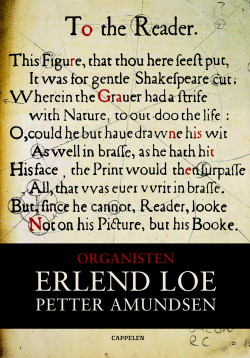 The cover of Amundsen’s book. The fact that he was able to lift from an arbitrary passage (Ben Jonson’s commendation of the Droeshout engraving of Shakespeare) his title word, “organisten,” would seem to rather take away from than lend credence to his other embedded findings.
The cover of Amundsen’s book. The fact that he was able to lift from an arbitrary passage (Ben Jonson’s commendation of the Droeshout engraving of Shakespeare) his title word, “organisten,” would seem to rather take away from than lend credence to his other embedded findings. Amundsen’s book is not yet available in English, but a brief foretaste of his findings may be found at BaconSocietyInc.org. In Shakespeare and the Rosy Cross: First Folio Breakthrough – Crucial Signatures Arose (Get it? Arose?), Amundsen asks the questions, “Might there have been a grander motive behind this issuance [of the First Folio] than merely the hope for pecuniary gain? Could someone else be sponsoring the publishers? Someone with an agenda?” Needless to say, Amundsen believes the answer is “yes.” The conclusion is reached that the Shakespeare First Folio was, in fact, both written and then published by the Rosicrucians, whose goal was to spread knowledge and free thought to all levels of British society through the medium of public theatre. As proof, Amundsen goes on to cite various pieces of evidence he has found within the text, each of which involves some complex number patterns that are, I am sorry to say, far over my head. They have something to do with 3 and 17, Pythagorean 3-4-5 triangles, and the number of times “rosie” appears in the First Folio.
“rosie” appears in the First Folio.
 “rosie” appears in the First Folio.
“rosie” appears in the First Folio. The word “CROSS,” discovered in Cymbeline, 2.4.
For example, Amundsen has this to say about the appearence of ”rosie” in Shakespeare’s Sonnet 116: “Sonnet 116 is the only sonnet with a numbering typo. It reads 119, an error of three. [...] Following the pattern observed in the Folio we jump 17 sonnets ahead. Sonnet 133 has the word crossed as word 69. This is an increment of three from Rosie which was word number 66, 17 sonnets back. Please recall that the typo consists of a 6 made into a 9. 3 = C. 17 = R. Rosicrucians called themselves cabalists. This warrants a geomatrical calculation of their chosen name, Rosie Cross. 17+14+18+9+5 + 3+17+14+18+18= 133. Just like the number of the “crossed” Sonnet.” Indeed.
A documentary has even been made about Amundsen and his discoveries. Called Sweet Swan of Avon: A Movie about the Greatest Mystery in Global Literature, it was produced by the Norwegian company AS Videomaker and The British Shakespeare Company of London. The film is not yet available on DVD, but you can watch the introduction here. I could definitely picture this finding a place on the History Channel – perhaps between Ancient Aliens and MonsterQuest?
In the end, Amundsen’s research leads him to, of all places, Oak Island, Nova Scotia. This enigmatic island, it turns out, is the wellspring of a whole host of lost treasure myths and has been given the moniker “the Money Pit.” It is thought to be the resting place of everything from Blackbeard’s secret pirate hoard to Marie Antoinette’s jewels, and even possibly the Holy Grail and/or the Ark of the Covenant. So, is this the resting place of this lost literary treasure – Bacon’s original writings and trove of Rosicrucian knowledge? Unfortunately, the story is stuck in a cliff-hanger for now. Exploration for riches of all sorts continues today on Oak Island, but Amundsen has not yet managed to unearth these  elusive documents.
elusive documents.
 elusive documents.
elusive documents.One blogger’s finding (“BACon”!), highlighted in red.
However, Amundsen’s work has inspired others to (re)jump on the Bacon bandwagon, as this blog shows. There’s even a Facebook group dedicated in support of Amundsen’s findings, with the understated title, “The worlds [sic] most important treasure is buried on Oak Island!!!” But is it? All of this has gotten me thinking: the offices of the ASC are located in an old Masonic building. Coincidence? I think not.
Natalie A.
PS. Researching Amundsen and his book has unearthed my own, Oak Island-worthy hoard of fun and fascinating Shakespearean conspiracies, some serious and some fictional. Therefore, I hope to make this entry the first part in a planned trilogy dealing with more of these findings. So, stay tuned...
This post immediately made me think of the Umberto Eco novel "Foucault's Pendulum", which played with a similar concept - that the works of Shakespeare might have been written by a committee of Rosicrucians - the novel follows three bored editors who begin inventing the mother-of-all-conspiracy theories out of conspiracy manuscripts sent to them, with the danger being that they create such a compelling theory that the conspiracy advocates become convinced the editors know some true hidden meaning and start persecuting them to make them reveal it. Eco incorporates many elements out of Shakespeare, for anyone who is interested in Shakespearean conspiracies I'd definitely recommend it.
ReplyDeleteYes! I just read that book recently. Talk about a truly dizzying array of legends/conspiracy theories/historical "cover-ups" all coming together! A definite brain bender.
ReplyDelete